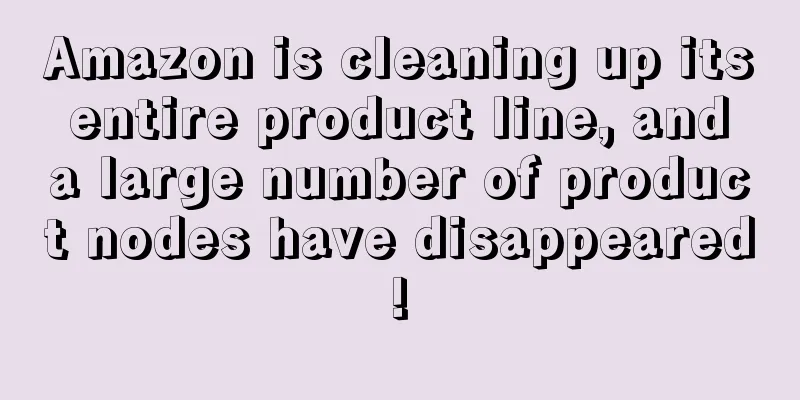Amazon is cleaning up its entire product line, and a large number of product nodes have disappeared!

|
Recently, the rankings and nodes of some sellers' product categories have suddenly disappeared. Sellers have tried various rescue measures, but to no avail. Currently, the nodes of most sellers have not been restored. In fact, this situation has started since last week. Many sellers reported that Amazon US is rectifying the behavior of merging multiple nodes and grabbing small category nodes to obtain BS marks. Sellers should be careful.
Amazon product categories and nodes disappear
“For one of my products, the category ranking and nodes suddenly disappeared,” a seller said on a social platform, but the nodes of competing products are currently normal.
On the front-end search page, the seller found that many places were not functioning properly. Not only could the brand name not be searched, but the ASIN and keywords were also not searchable. Currently, advertisements can be opened normally, and all orders are placed through advertising channels.
The seller tried to open a case to inquire about the reason, but the customer service replied: There is nothing wrong with the product, and your products are all available for sale. At the same time, when the seller checked ASIN in the backend by themselves, it also showed that there was no abnormality and it was available for sale. In order to quickly restore the node, the seller also tried to open a case, refresh the product node with a table, and use FBA and FBM conversion to let the system re-crawl the node, but none of them worked.
Coincidentally, this situation did not occur to just one seller.
Some sellers said that their nodes were automatically replaced by the Amazon system and switched to an unrelated category. The original product classification was Category A, Subcategory A, and the current nodes are Category B, Subcategory B. After one day, the order rate of natural orders dropped from 70% to 20%, of which 20% may be orders added to the cart a few days ago. Currently, the seller repaired the product classification page through the backend and got the following prompt ↓
We have reviewed your suggestion and are unable to accept the proposed category node change for ASIN xxx. The current category node for this product is assigned based on the detail page and how Amazon customers find the product through search and browsing.
The same thing happened to another seller. After the product category was forcibly modified, the normal application for category change also showed the same prompt as the above seller. However, the difference was that one of the seller's products was classified into an irrelevant category, and a performance warning was issued indicating that the classification was wrong, which made the seller exclaim, "Is Amazon crazy again?"
As soon as the news came out, it caused a stir in the cross-border circle. Many sellers said that this situation started last week, and Amazon is vigorously rectifying the behavior of obtaining BS marks by merging multiple nodes and occupying small category nodes. Most of these are large category nodes and daily bulk consumer goods with high sales volume occupying some small nodes with BS marks.
According to incomplete statistics, more than 70% of categories have been removed from multiple nodes. Currently, Amazon’s main method of rectification is to unify the merged multi-node listings into only one node and one ranking, and then lock the node in the variant, so that it will be difficult for sellers to modify the node in the future. At the same time, sellers also need to pay attention that different nodes cannot share reviews and rankings now, otherwise the nodes and rankings of the old links will be lost.
Amazon's move shocked many sellers. Some operators were worried about themselves, fearing that if Amazon came to settle accounts with them, they would be affected and they would have nothing to do but cry. Some sellers were cracking melon seeds, holding an attitude of watching the show, jokingly saying: "I'll go and see if those mobile phone cases that dominated the auto list are still selling well."
Initially, some sellers gave several reasons for the disappearance of nodes: first, the category selected when the product was listed was inaccurate, which made it impossible to search it on the front desk; second, multiple nodes of the product were obtained through manual operation, which is what we call black technology, or fake orders; third, the product encountered an audit node and would be restored once the time is up.
However, after investigation, the editor found that after this situation lasted for several hours, the seller's node did not recover. Some sellers speculated that the second possibility was the most likely reason. Amazon should be rectifying sellers who arbitrarily and illegally added small nodes.
For sellers, this is undoubtedly another heavy blow. Combined with the situation provided by sellers last week, it can be seen that Amazon's rectification this time is obviously carried out in batches, and it is not ruled out that it will affect some sellers in other categories in the future.
Amazon is rectifying the phenomenon of multiple nodes, sellers need to be cautious
On Amazon, the platform uses the numbers in the BTG to assign products to one or more classification nodes. Generally, products have two category nodes, and some products even have more. The more nodes there are, the more accurate and specific the classification information of the product is, the more paths the product is searched for, the more exposure and traffic the product receives, and the greater the chance that the product will be searched by target customers.
Many sellers know that due to excessive sales in large nodes, some small nodes are more likely to get Best Seller, New Release, and Amazon Choice logos than large nodes. These logos will also bring greater exposure to the products and increase the click-through rate and conversion rate of the products.
Therefore, some sellers started to think of various ways to get more nodes.
It is understood that in order to obtain the Best Seller logo, some sellers would choose less competitive borderline categories when uploading products. For example, a certain popular product would cost a lot of money to push up in a large category. If sellers want to grab the Best Seller logo in a category, some sellers will put the product in a small category with less competition, and grab the Best Seller logo by deliberately putting it in other unrelated small categories.
There are countless similar examples, and some sellers put auto parts products under the category of maternal and child products. Some sellers even spent huge amounts of money to use black technology to interfere with the rankings in order to get more nodes, so that their product rankings can climb rapidly.
This type of operation by sellers is extremely prevalent on the platform, especially since the end of last year, when it has become rampant, causing chaos in various category nodes and BS products.
However, for Amazon, this method of adding nodes has violated the relevant rules of the platform. The product may survive for a short period of time, but once it is discovered later, Amazon will eventually remove the nodes and even demote the seller, which is a big blow to the seller. If some problems persist, Amazon may no longer allow sellers to sell products on the platform.
Some sellers have sorted out some ways to add Amazon nodes: first, open a case and ask customer service to add it. Generally speaking, VC accounts have a higher success rate in opening cases, while ordinary accounts rarely succeed; second, modify the node in the table. On the premise that the product has an order record, select the node at the same level as the previous node, enter the new node keyword, select partial update, and a new node will appear after the order is placed; finally, advertise. Use the keywords of the category you want to add for advertising. As the number of orders increases, Amazon will default to the category you entered as your node and add this node for you.
Of course, sellers also need to pay attention to the fact that when adding nodes, they must choose the category where the Best Seller is located. Do not choose irrelevant categories just to reduce competition, otherwise it will be counterproductive, especially when Amazon cracks down on it. At the same time, do not add too many nodes, otherwise you will be punished sooner or later. Product Node disappear Amazon |
<<: After its wild growth, how much market share has Walmart taken away from Amazon?
Recommend
Canadian retail sales are expected to see new growth in September!
According to foreign media reports, Canada's ...
What is Harry's Razors Company? Harry's Razors Company Review, Features
Founded in 2013, New York-based Harry's Razor...
Meikeduo releases second quarter financial report, revenue jumps 93.9%
Latin American e-commerce giant MercadoLibre rele...
10club raises $40 million in seed funding as Indian e-commerce aggregation business heats up
According to the Times of India, Indian e-commerc...
What is Detsky Mir? Detsky Mir Review, Features
Detsky Mir is a multi-format digital retail opera...
The summit has concluded successfully! All the great tips for independent websites are here…
The 2021 First China (Zhengzhou) Central Cross-bo...
Ranking of the most commonly used online shopping apps by Koreans in March
It is undeniable that thanks to the outbreak of t...
Full opening! Amazon's best-selling categories began to frequently reduce prices
For Amazon sellers, this year's operations ha...
Signet Jeweler Sales Soar Because Millennials Are Eager to Get Married
Founded in 1949 and headquartered in Akron, Ohio ...
Revenue of more than 2.1 billion in 9 months! Shenzhen Dashao "kills" the siege in the trillion-level track
The 3C track is now a well-deserved "super r...
Policy update: Wish has relaxed some product restrictions
The platform said that in order to help sellers c...
What is Innoventry? Innoventry Review, Features
<span data-docs-delta="[[20,{"gallery"...
What is Urbanog? Urbanog Review, Features
Urbanog is an internet-based fashion store that st...
eBay UK clothing sales surge after UK lockdown
eBay's UK advertising arm said it had seen a ...
What is EC EXPRESS? EC EXPRESS Review, Features
EC EXPRESS is a high-quality brand of cross-border...









